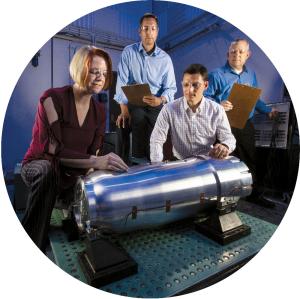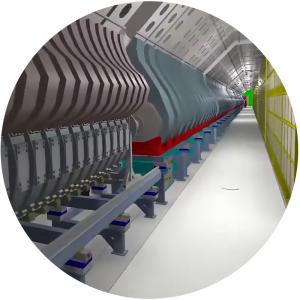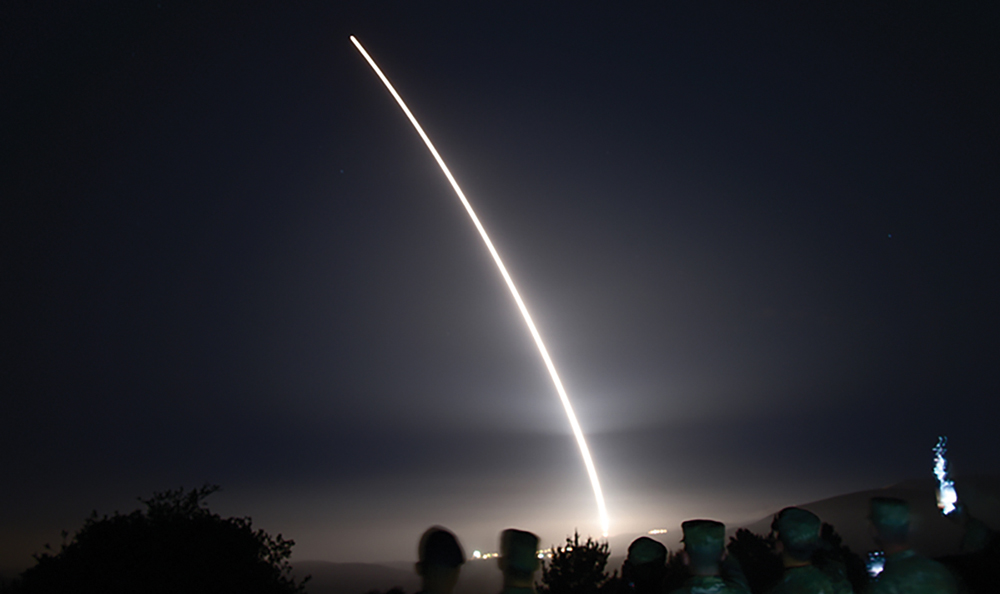LLNL’s foremost responsibility is to ensure the performance of the nation’s nuclear arsenal without nuclear testing. Knowledge gained through experiments, theory, and simulations is applied to assess the condition of current weapons and pursue programs that jointly modernize the stockpile and weapons production processes.
Annual Stockpile Assessment
In FY 2021, LLNL completed Cycle 26 of the annual stockpile assessment. The process included a formal comprehensive peer review between LLNL and Los Alamos National Laboratory (LANL) of each other’s weapon systems. Laboratory scientists performed experiments and enhanced physics and engineering simulation codes to improve predictability and strengthen the technical foundation that supports assessments and certification of weapons. LLNL also completed needed surveillance, testing, and analysis activities to assess the condition of and sustain the B83, W80-1, and W87-0 stockpile systems.
Stockpile Modernization Programs
LLNL is partnered with Sandia National Laboratories (SNL) as the design agencies to develop and certify the W80-4 warhead for the bomber-delivered Long-Range Standoff missile. The Laboratory is making excellent progress in Phase 6.3 (development engineering) of the W80-4 Life-Extension Program (LEP) and preparing to enter Phase 6.4 (production engineering) in FY 2022. The design of the nuclear explosives package (NEP) has matured, and the team is preparing for formal system reviews. One notable accomplishment was LLNL’s completion of its first high-fidelity engineering ground test. An NEP engineering test device demonstrated that the baseline design can survive expected thermal and vibrational environments. The plans to refurbish or replace aging components and materials in the W80-4 include using new manufacturing methods that minimize costs, increase throughput, and reduce the need for environmentally sensitive materials and processes.
The W87-1 Modification Program completed Phase 6.2 (program feasibility) in August 2021 and moved to Phase 6.2A. During this phase, the Weapon Design and Cost Report will be developed. LLNL is NNSA’s design agency for the NEP for a ballistic-missile warhead to replace the aging W78. To be deployed on the U.S. Air Force’s Ground Based Strategic Deterrent in 2030, the W87-1 will be the first modern warhead in the stockpile that is 100 percent newly manufactured. Technical activities are focusing on maturing weapon design options and modern manufacturing methods.
Enclaves and Partnerships
The W80-4 and W87-1 programs require the full array of NNSA’s computational, experimental, and manufacturing capabilities, which must be upgraded and better integrated to meet stringent production deadlines in an efficient, cost-effective manner. The use of enclaves is a pioneering approach to accelerate design-to-deployment. LLNL’s new Polymer Production Enclave, established in partnership with the Kansas City National Security Campus (see Partnerships), exemplifies this approach. Additional partnerships include work with the Y-12 National Security Complex on minimal-waste uranium component production and with the Holston Army Ammunition Plant on manufacturing insensitive high explosives (HEs). Stockpile modernization also requires partnerships in weapon pit manufacturing with LANL and Savannah River National Laboratory and in the LANL-led Scorpius project to deliver greatly enhanced subcritical experimental capabilities at the Nevada National Security Site.
Preparing for Exascale
Ranking third on the November 2021 TOP500 list of the world’s fastest supercomputers, LLNL’s Sierra provides outstanding support to the three NNSA laboratories. Scientists use the machine to run high-fidelity multiphysics simulations that address high-priority issues. In FY 2021, LLNL computer scientists made excellent progress in developing a next-generation, production quality, multiphysics code. Their attention is on the next major advance in supercomputer size and architecture: El Capitan, with peak performance expected to exceed 2 exaflops (quintillion calculations per second). Delivered in February 2021, the “RZNevada” early-access system—small and as similar to El Capitan as feasible—provides experts at the NNSA laboratories an opportunity to develop and test applications ahead of El Capitan’s arrival in 2023, perhaps as the world’s fastest supercomputer. The $100 million Exascale Computing Facility Modernization project is preparing LLNL for this delivery (see Safe, Secure, and Sustainable Operations). Laboratory researchers are also fully engaged in DOE’s seven-year $1.8 billion Exascale Computing Project, which is addressing the many technological challenges that the leap to exascale presents (see Science and Technology).
Stockpile Stewardship Experiments
Despite COVID-19 protocols, wildfires, hazardous air quality, and extreme heat, LLNL successfully conducted nearly 100 experiments at remote Site 300 in FY 2021, including key integrated weapons experiments that supported critical design decisions for the W80-4 LEP. In addition, more than 650 shots were fired at the High Explosives Applications Facility. In combination with simulations, these shots helped scientists to better understand details about the shock initiation and detonation properties of HEs. Experiments at the Joint Actinide Shock Physics Experimental Research (JASPER) Facility and the National Ignition Facility (see National Ignition Facility) provided essential data about materials at extreme conditions. JASPER experiments in FY 2021 supported pit certification for the W87-1 Modification Program.
Flight Test of Minuteman III/W87-0
In February 2021, a Minuteman III intercontinental ballistic missile was launched from Vandenberg Space Force Base. A W87-0 nonnuclear joint test assembly, designed by LLNL and SNL, was on board. The stockpile flight test program serves to validate and verify the safety, security, effectiveness, and readiness of the weapon system. Data gathered from such tests are analyzed and incorporated into the annual assessment of the W87-0.








